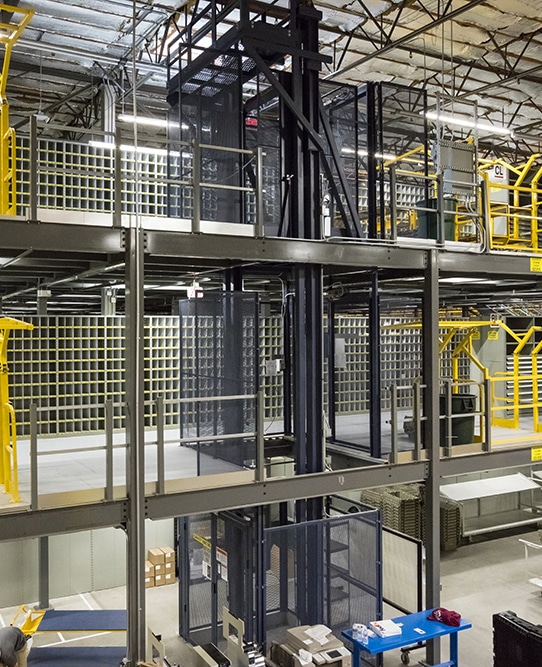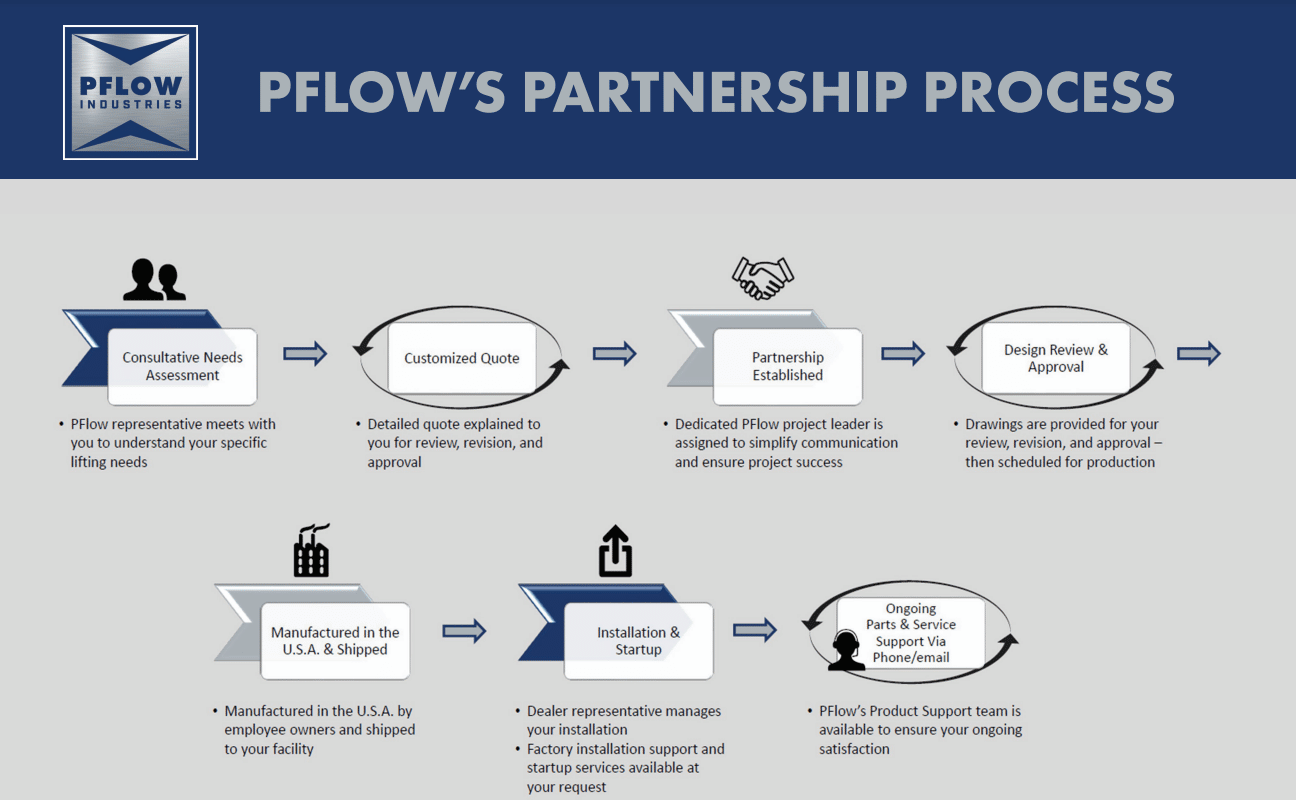
VRC Installation: What to Expect and How to Prepare
If you are preparing to install a vertical reciprocating conveyor (VRC) in your factory or warehouse — smart move! VRCs can add big benefits whenever goods are being moved between two or more levels, adding efficiency and safety to your workflow and reducing wear, tear, and downtime.
Let’s take a look at what to expect if you’re expecting a VRC installation at your facility, and what you can do to prepare your operation for the new arrival.
How Long Will It Take?
How long does a VRC installation typically take? It depends on a couple of factors:
- The total vertical travel of the VRC. The more floor levels that are being serviced, the longer the installation.
- The level of guarding required. Safety guard and gate requirements are determined by the unique needs of each site.
- Component pre-wiring. PFlow can help customers reduce on-site installation time by pre-wiring certain parts of the VRC.
- Building access. PFlow offers knock-down construction. This means that certain VRC components are shipped “de-constructed” so they can fit through smaller building access points, which means more on-site assembly and installation time.
- Lift placement. If the VRC is going to be installed in an existing elevator shaft, there may be additional time needed to remove the elevator and its components.
How Can I Prepare for a VRC Installation?
As an equipment end-user or materials handling professional, you can help ensure your VRC installation goes smoothly by taking the following steps:
Ahead of the installation date:
- Consult with the installer to ensure the entryway and path to the installation site are large enough to accommodate VRC components.
- Ensure entry points and construction pathways are clear of obstacles and debris.
- Ensure there is plenty of workspace around the unit to allow for safe and efficient installation.
- Ensure that the installation area has access to the electrical power needed to install and operate the unit.
During installation ensure the installation area and pathways to it remain free of clutter and obstacles.
What Does Installation Involve?
While companies like PFlow will customize each unit to meet the needs of your particular space and workflow, there are six standard steps to most VRC installations:
- Column Setting: The columns that will support and guide the load-bearing parts of the unit are set and bolted into place. For some large installations it might be necessary to set the guide columns in place using an overhead crane through an opening in the building’s roof.
- Carriage installation: The carriage is mounted inside the columns and supported using wheel blocks and lift chains.
- Drive base installation: For our mechanical VRCs, a drive base is lifted into place on top of the columns. Once the motor drive is installed and connected, it is bolted down.
- Safety equipment: Gates and enclosures critical to ensuring the safe operation of the lift are installed and bolted and/or welded into place.
- Electrical: Electrical installer completes the connection of the equipment as shown on the electrical and general arrangement drawings.
- Checklist and Testing: Installers ensure the installation checklist is completed, the unit is tested at full load capacity, and all gates are checked to ensure proper operation of interlocks.
What About Training?
While PFlow’s units are designed to be easy to use, it’s important that your staff understands how to safely operate your VRC. Minimum training should include:
- Communicate how to operate the VRC.
- Reiterate that people should never ride the lift.
- Have each person operate the lift.
We recommend that at least one person on each shift be designated as an official point person for any questions about VRC safety. Ensure that only qualified personnel are allowed to perform maintenance on the VRC.
How Can You Minimize Disruption During Installation?
Your new VRC will form a key part of your operation therefore its installation will inevitably involve some disruption of your workflow. You can help minimize this by:
- Finding temporary storage space for materials kept near the installation site.
- Choosing an installation time that will disrupt your business the least—for instance, after hours or on weekends, and ideally during your least busy time of year or a previously scheduled operations shut-down.
- Having an alternative plan for moving materials during installation. Consider adding temporary equipment if your current system will be out of operation.
With PFlow It’s More Than an Installation
PFlow is a leading supplier of customized VRC systems to a wide range of industries. Whether you are a materials handling specialist or an equipment end-user, we partner with you to deliver industry-leading service at every stage of the procurement process, from customized concept to expert installation.
As part of our trademark Partnership Process, PFlow’s experts will work with you to:
- Understand your specific needs and develop a customized quote
- Design, manufacture, and ship equipment that meets your exact requirements
- Oversee installation including factory support and start-up services
- Provide ongoing product support to ensure satisfactio

We guarantee that our equipment meets code approval in every state and conforms to ASME B20.1 standards.
Begin your VRC partnership with PFlow today. Click below to try out our vertical conveyor configurator and find a solution for your material lift needs.
